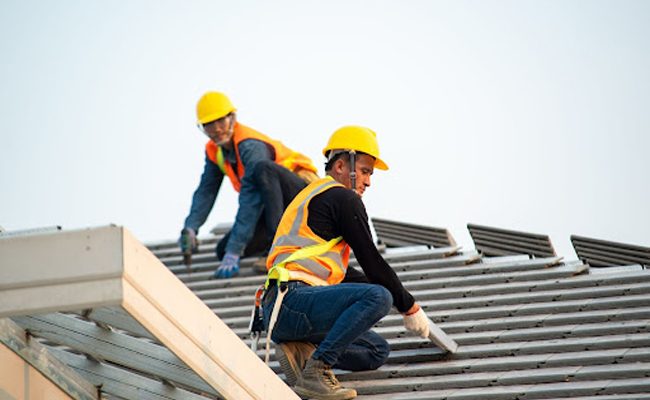
While the roof pitch is one of the minor concerns that homeowners have when it comes to finishing their construction, it is critical to take it into account. The type of shingles you install and the climatic condition determine your roof’s slope.
Besides, the roofing installation method you choose also determines if you will have a steep or low roof. However, a professional roofer should advise the homeowner on the best roof pitch, depending on their home’s architectural design.
There are more factors affecting a roof pitch, but before looking at them, you first need to know what a roof pitch is and its importance. We will then mention the factors that will affect the type of roof pitch you install.
Let us dive into it.
What Is A Roof Pitch?
A roof pitch is the slope of the roof formed by the rafters. You can measure it as the angle formed between the rafters and the horizontal part of the roof. Additionally, the roof pitch is determined by looking at the ratio between the rise and run of the roof.
Roof pitch makes the different categories of roofs which are;
Flat Roofs
Although they seem entirely flat, flat roofs need a slight slope to allow water to runoff. Making them completely flat can lead to water damage on the shingles and other roof problems like leaks.
Low Pitched Roof
Low-pitched roofs are more prone to leaks because of difficulties in water drainage. Besides, these roofs are also challenging to maintain, but you can install insulation materials to prevent leaks.
Conventional Roofs
Conventional roofs are slightly raised, and they are the most straightforward roofs to construct. You will also experience fewer roof problems with conventional roofs, and there are low chances of water leaks because water drains well into the gutters.
High Pitched Roofs
The high-pitched roofs are quite high. They are hard to construct and require a very experienced and professional roofer. Besides, the high pitched roofs require additional fasteners than the other roof types.
The roof pitch is important because it determines the roofing materials to install. Besides, this type of roof adds aesthetics to the building, although you should choose it considering the home’s architectural design. A higher roof pitch will also increase your roof’s durability.
Factors That Affect Roof Pitch
Although the roof pitch is important, there are different factors to consider before selecting the pitch. These factors also affect your roof’s performance, longevity, and roofing materials. Let us look at them in-depth.
The Climatic Conditions
If you live in cool, snowy, and rainy climates, a pitched roof will be ideal for your house. It enables water and snow to run off the roof, reducing the chances of roof leaks and rotting of the shingles. A low-pitched roof is not recommended for wet climates because the shingles take longer to dry up.
Also, if you experience heavy winds, a steep roof would be an excellent option to reduce the wind suction forces, which could blow off your roof’s shingles. Ensure the installer uses enough nails to fix the roofing materials.
Types of Roofing Materials
The roofing materials you install will affect your roof pitch. Some materials are suitable for low-pitched roofs, while others fit perfectly in high-pitched roofs. For example, you can install tar and gravel shingles or the rubber membrane on flat roofs.
Asphalt, wood, and slate tiles are suitable for roofs with steep slopes. The different shingles on the high or low pitched roof affect water flow when it rains and water penetration. For instance, since wood absorbs water fast, it is not suitable for flat roofs.
Maintenance
High and low pitched roofs have different maintenance practices. For example, high-pitched roofs have better drainage, so homeowners are less likely to suffer drainage problems.
Flat roofs require constant cleaning because debris and dust settle on regular roofs more easily than on pitched roofs. Besides, flat roofs are easy to maintain because they are easier to walk and work on. Roofers are likely to slide on high-pitched roofs.
Budget
Your budget will determine the roof slope you’ll buy. Flat or low-pitched roofs are cheap and less complicated to install. Besides, they require a small roofing material because there are no extended areas.
You will spend more money to install the high-pitched roof because it requires more expertise and workmanship. Besides, the high pitched roof uses more roofing material, increasing the cost. Because of the challenges, installers will also charge high labor fees when working on steep roofs.
Rooftop Installation
A flat roof will be ideal if you plan to have other systems like the HVAC unit, solar system, and a rooftop patio. These roof additionals increase energy efficiency and your home’s comfort. Although installing a solar system on a high-pitched roof is possible, it is easier on a flat roof.
Curb Appeal
Your home’s curb appeal will also depend on the type of roof pitch you choose. Most homeowners prefer a pitched roof because it adds more aesthetics to the house than a low-pitched roof.
Also, a pitched roof allows the homeowner to choose between various designs than a low roof. However, what you choose should also depend on your home’s architectural design and your taste and preference. You can also ask the installer for advice.
Is There A Best Pitch For A Roof?
The best roof pitch a homeowner can go for depends on the style of the roof. A flat roof fits homes built with a modern style while the traditional houses look better with the high pitched roofs. However, it is essential to consider other factors like climate and budget.
Final Words
Choosing a roof pitch can be difficult because the numerous varieties affect the curb appearance of your roof and property. However, factors such as the climatic conditions in your area and the roofing materials you use will influence the roof pitch you select. Hopefully, the mentioned factors will help you with your roof pitch selection.
Leave a Reply